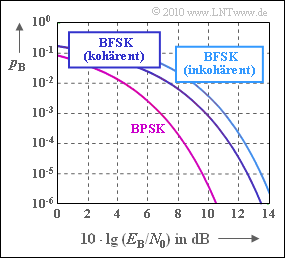Exercise 4.16: Comparison between Binary PSK and Binary FSK
KORREKTUR: Titel "Erercise" The graph shows the bit error probability for binary FSK modulation $\rm (BFSK)$ in
- coherent demodulation , as well as in
- non-coherent demodulation
in comparison with binary phase modulation $\rm (BPSK)$.
Orthogonality is always assumed. For coherent demodulation, the modulation index can be a multiple of $h = 0.5$ , so that the middle plot can also apply to Minimum Shift Keying $\rm (MSK)$ . In contrast, for non-coherent demodulation of BFSK, the modulation index must be a multiple of $h = 1$ .
This system comparison is once again based on the AWGN channel , characterized by the relationship $E_{\rm B}/N_0$. The equations for the bit error probabilities are as follows
- for Binary Phase Shift Keying $\rm (BPSK)$:
- $$p_{\rm B} = {\rm Q}\left ( \sqrt{{2 \cdot E_{\rm B}}/{N_0 }} \hspace{0.1cm}\right ) = {1}/{2}\cdot {\rm erfc}\left ( \sqrt{{E_{\rm B}}/{N_0 }} \hspace{0.1cm}\right ),$$
- for Binary Frequency Shift Keying $\rm (BFSK)$ with coherent demodulation:
- $$p_{\rm B} = {\rm Q}\left ( \sqrt{{E_{\rm B}}/{N_0 }} \hspace{0.1cm}\right ) = {1}/{2}\cdot {\rm erfc}\left ( \sqrt{{E_{\rm B}}/(2 N_0 )} \hspace{0.1cm}\right ),$$
- for Binary Frequency Shift Keying $\rm (BFSK)$ with incoherent demodulation:
- $$p_{\rm B} = {1}/{2} \cdot {\rm e}^{- E_{\rm B}/{(2N_0) }}\hspace{0.05cm}.$$
It was shown in Exercise 4.8 , that for BPSK, the log ratio $10 · \lg \ E_{\rm B}/N_0$ must be at least $9.6 \ \rm dB$ so that the bit error probability does not exceed $p_{\rm B} = 10^{–5}$ .
HinTS:
- This exercise belongs to the chapter Nonlinear_Digital_Modulation.
- However, reference is also made to the page Linear_Digital_Modulation.
- Use the approximation $\lg(2) ≈ 0.3$.
Questions
Solution
- In anderen Worten: Die kohärente BFSK–Kurve liegt um $10 · \lg (2) ≈ 3 \ \rm dB$ rechts von der BPSK–Kurve.
- Um $p_{\rm B} \le 10^{–5}$ zu garantieren, muss daher gelten:
- $$10 \cdot {\rm lg}\hspace{0.05cm}{E_{\rm B}} /{N_{\rm 0}}= 9.6\,\,{\rm dB} + 3\,\,{\rm dB} = \underline{12.6\,\,{\rm dB}}\hspace{0.05cm}.$$
(2) Richtig ist der Lösungsvorschlag 2:
- Die angegebene Gleichung gilt nicht nur für die MSK $($diese ist eine FSK mit $h = 0.5)$, sondern für jede Form von orthogonaler FSK.
- Eine solche liegt vor, wenn der Modulationsindex $h$ ein ganzzahliges Vielfaches von $0.5$ ist, zum Beispiel für $h = 1$.
- Mit $h = 0.7$ liegt keine orthogonale FSK vor.
(3) Aus der Umkehrfunktion der angegebenen Gleichung erhält man:
- $$\frac{E_{\rm B}} {2 \cdot N_{\rm 0}}= {\rm ln}\hspace{0.05cm}\frac{1}{2 p_{\rm B}}= {\rm ln}(50000)\approx 10.82 \hspace{0.3cm} \Rightarrow \hspace{0.3cm}{E_{\rm B}} /{N_{\rm 0}}= 21.64 \hspace{0.3cm}\Rightarrow \hspace{0.3cm} 10 \cdot {\rm lg}\hspace{0.05cm}{E_{\rm B}}/ {N_{\rm 0}}\approx \underline{13.4\,\,{\rm dB}}\hspace{0.05cm}.$$
(4) Aus $10 · \lg \ E_{\rm B}/N_0 = 12.6 \ \rm dB$ folgt:
- $${E_{\rm B}} /{N_{\rm 0}}= 10^{1.26} \approx 16.8 \hspace{0.25cm}\Rightarrow \hspace{0.25cm} ({E_{\rm B}} /{N_{\rm 0}})/2 \approx 8.4 \hspace{0.25cm} \Rightarrow \hspace{0.25cm} p_{\rm B} = {1}/{2} \cdot {\rm e}^{- 8.4} \approx \underline{1.12 \cdot 10^{-4}}\hspace{0.05cm}.$$
Das heißt: Bei gleichem $E_{\rm B}/N_0$ wird die Fehlerwahrscheinlichkeit bei inkohärenter Demodulation gegenüber kohärenter Demodulation (siehe Teilaufgabe 1) um etwa den Faktor 11 vergrößert.
